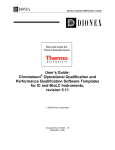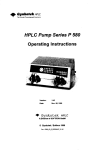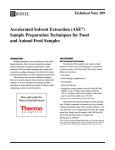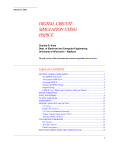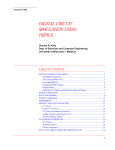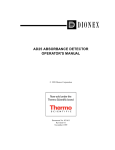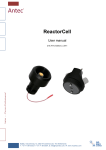Download TN 700: Optimizing the ASI-100 Autosampler Injection
Transcript
Technical Note 700 Optimizing the ASI-100™ Autosampler Injection Precision and Linearity Using PrimeSyringe INTRODUCTION When laboratories need to quantify analytes at high precision, an autosampler with a precise mechanic and fluidic design is mandatory. However, even with quality instruments, users need to follow basic rules of proper operation to achieve good day-in and day-out performance. There are several characteristics of automated injectors that a chromatographer should be aware of. The most common instrument-related causes for poor quantitative precision are: • Gas bubbles in the injection system • Inappropriate draw speed—the speed at which the autosampler draws the sample into the injection loop • Worn-out parts (needleport seal, rotor seal, syringe plunger, etc.) • Insufficient vial pressure equilibration during sample loading This technical note focuses on the effects of gas bubbles and draw speed on autosampler performance using the Dionex ASI-100 Autosampler. The instrument’s user manual addresses the two other causes of substandard autosampler performance mentioned above. This technical note shows how an automated gas bubble removal command— PrimeSyringe—effectively eliminates gas bubbles and, therefore, significantly improves autosampler performance, ease of use, and reliability. This document describes the PrimeSyringe procedure for purging gas out of the system and recommends draw speeds for common syringe sizes. The described operations help achieve typical peak area relative standard deviations (RSDs) of better than 0.2% and a high injection linearity. This performance is demonstrated using two application examples. Operating the ASI-100 with Chromeleon® software allows users to automate wash routines and integrate them into their daily analytical work. EXPERIMENTAL PrimeSyringe Procedure The PrimeSyringe command automatically eliminates gas bubbles from the autosampler flow path and therefore improves performance, ease of use, and reliability. The operational principle of PrimeSyringe is based on preconditioning the injection syringe with a wash liquid and then eluent prior to sample injection. During this procedure all gas bubbles are also purged. We recommend performing the PrimeSyringe procedure with isopropanol, after which the procedure must be repeated with the current eluent. To avoid carryover, this technique is strictly forbidden using samples. Steps 1–3 of the following procedure are executed automatically without user interaction. Technical Note 700 1 Step 1 The pump flow is off. The injection valve switches to the “Load” position, allowing pump flow to bypass the sample loop and needle. The needle descends into the selected wash vial and the syringe draws a full syringe volume (Figure 1). Waste Sample needle Injection syringe Step 3 The injection valve switches to “Load” position and the procedure (steps 1 and 2) is repeated four more times. During this process, the wash liquid reaches the syringe, removing gas bubbles and exchanging the syringe contents. After completion of the PrimeSyringe procedure, the needle moves back to the needle port and the injection valve switches to “Inject”. After reestablishing the pump flow, the flow path is as illustrated in Figure 3. Although most of the liquid in the injection system is replaced by the current eluent, the segment between the syringe and the valve is not (it remains filled with the wash period). Needle port Wash vial Waste Sample needle Column Pump Figure 1. Needle in the wash vial and syringe draws full volume. Wash vial Step 2 The injection valve switches back to the “Inject” position, while the needle remains in the wash vial. The syringe plunger pushes the liquid contained in the syringe to waste (Figure 2). Waste Sample needle Wash vial Injection syringe Injection syringe Needle port Column Pump Figure 3. ASI-100 liquid flow path after PrimeSyringe procedure with isopropanol. Next, the PrimeSyringe procedure is repeated with the current eluent composition of the application (though without modifiers such as buffer salts) to ensure that the whole liquid flow path of the autosampler is purged with the same liquid. Observing this procedure more closely reveals that a few parameters must be considered prior to starting PrimeSyringe: Needle port Column Pump Figure 2. Injection valve in the “Inject” position with the needle still in the vial. 2 Optimizing the ASI-100 Autosampler Injection Precision and Linearity Using PrimeSyringe • The pump flow must be off. If not, the pump would deliver eluent into the wash vial as soon as the injection valve switches from “Load” to “Inject” (see Figure 2). • The syringe wash and dispense speed have to be set according to the syringe used (see Table 1). Note that “wash speed” instead of “draw speed” has to be set when using a “wash vial”. • A PrimeSyringe wash solution and the wash vial position have to be defined. • The procedure has to be run twice—first with isopropanol, then with the current eluent. We recommend the use of isopropanol (2-propanol) as wash solution, as it effectively removes gas bubbles from the system. The PrimeSyringe procedure has to be repeated with the current eluent to remove isopropanol completely from the system. In case the current eluent contains a buffer, a corresponding eluent composition without buffer addition is recommended to avoid crystallization or microbiological growth in the syringe. Table 1 lists the recommended ASI-100 settings for different syringes. In addition to effectively removing gas bubbles, the PrimeSyringe command allows for a complete liquid exchange in the autosampler. As can be seen in Figure 3, just switching between “Load” and “Inject”, does not exchange the liquid between the syringe and switching valve. To completely exchange the liquid in the flow path of the autosampler, the PrimeSyringe procedure has to be repeated with the current eluent. Therefore, the PrimeSyringe procedure may also be used when switching between incompatible applications (e.g., from reversed-phase to normal-phase applications). The PrimeSyringe command can easily be executed from the ASI-100 Chromeleon control panel (available on every Chromeleon installation CD) as illustrated in Figure 4. The PrimeSyringe button can be included easily in any existing control panel. Table 1. Recommended ASI-100 Settings for PrimeSyringe Syringe 100 µL 250 µL 1000 µL* 2500 µL* Draw speed (µL/s) 5 10 25 25 Dispense speed (µL/s) 5 10 50 50 Delay time (s) 5 5 5 5 *In general, PrimeSyringe is not required to remove gas bubbles from a 1000- or 2500-µL syringe. With either large syringe, a full syringe injection of eluent is usually sufficient to remove gas bubbles. Technical Note 700 3 Figure 4. ASI-100 Chromeleon control panel with PrimeSyringe command. Peak Area Precision Example Eluent Component A: 0.02 M tetrabutylammonium sulfate in HPLC-grade water, pH 2.3 Eluent Component B: Acetonitrile Composition: Sample Concentration: 0.5 g/L chloranil dissolved in acetonitrile Vials: 2-mL crimped vials with unslotted septa Detection Wavelength: 289 nm Column Temp.: 25 °C Eluent A/B (40/60), isocratic premixed Draw Speed: 25 µL/s for Test 1 and 2 and 10 µL/s for Test 3 ® Column: Dionex Acclaim 120, C18, 5 µm, 150 × 4.6 mm Delay Time: 5s Flow Rate: 0.8 mL/min Instruments: Inj. Volume: 5 µL P580A HPG-2 with external degasser, ASI-100T, STH-585, and UVD 340U 4 Optimizing the ASI-100 Autosampler Injection Precision and Linearity Using PrimeSyringe Autosampler Injection Linearity Eluent: Backpressure Coil: HPLC-grade water PEEK restriction capillary, 13 m × 0.13 mm i.d. Flow Rate: 1.0 mL/min Inj. Volume: 5, 10, 20, 40, and 80 µL A peak area trend plot is presented for each test setup. The customer’s target was to achieve an RSD of less than 0.5%. The “2S” limits of the trend plot have been set accordingly. Peak Area UV_VIS_1 Sample Concentration: 10 mg/L caffeine Vial: 2-mL crimped vial with unslotted septa Detection Wavelength: 272 nm 2s Mean 2s 0 1 2 3 Column Temp.: 25 °C Draw Speed: 25 µL/s Delay Time: 5s Instruments: P680A LPG, ASI-100T, TCC-100, and PDA-100 4 5 6 Sample Number 7 8 9 21014 Figure 5. Test 1: ASI-100 with a draw speed of 25 µL/s, three consecutive injections per vial, 30-µL gas bubble in the syringe— trend plot, n = 9, 1.9% RSD obtained. Peak Area UV_VIS_1 2s THE EFFECT OF GAS BUBBLES AND SAMPLE DRAW SPEED Mean Peak Area Precision The precision of peak areas depends not only on the autosampler’s capability to inject samples precisely, but also on the precision of data processing and absence of application-specific effects (e.g., analyte adsorption to fluidic surfaces). However, when all other effects are minimized through the experimental setup, peak area precision is a good measure of the autosampler’s injection volume precision. The following application example was an actual support case from a Dionex customer. The customer observed poor peak area precision, with relative standard deviations in the range of 1–2%. Troubleshooting the customer’s instrument, we found that the poor precision could be attributed to gas in the injection system. Gas bubbles in the injection system are a common issue with autosamplers. Some designs attempt to resolve the gas issue by using a flow-through injection syringe. Unfortunately, this design has the undesirable side effect of a significantly increased (and variable) dead volume. Gas bubbles (originating from incompletely degassed eluents or small leaks) may form in the injection system, for example, when the instrument is not operated over a weekend. As shown in our example, an automated syringe-priming procedure eliminates the issue. 2s 0 1 2 3 4 5 6 Sample Number 7 8 9 21015 Figure 6. Test 2: ASI-100 with a draw speed of 25 µL/s, three consecutive injections per vial, after PrimeSyringe—trend plot, n = 9, 0.40% RSD obtained. Peak Area UV_VIS_1 2s Mean 2s 0 1 2 3 4 5 6 Sample Number 7 8 9 21016 Figure 7. Test 3: ASI-100 with a draw speed of 10 µL/s, three consecutive injections per vial, no gas bubble—trend plot, n = 9, 0.20% RSD obtained. Technical Note 700 5 A gas bubble in the syringe causes a dramatically negative effect on the peak area RSD of the peak area (see Test 1 in Figure 5). The automatic PrimeSyringe procedure effectively removes the gas bubble and brings the relative standard deviation back into an acceptable range (customer’s target was less than 0.5% RSD). Although the draw process of the sample took only 0.2 s with the 25 µL/s draw speed setting, satisfactory RSD values were obtained because there was no gas bubble in the syringe (see Test 2 in Figure 6). Reducing the draw speed to 10 µL/s (Test 3) improves the RSD further (Figures 6 and 7 compare the results). These results were statistically confirmed performing an F-test and t-test at 95% confidence level. AUTOSAMPLER INJECTION LINEARITY Modern autosamplers allow the injection of variable volumes. Therefore, it is important to ensure an injection linearity range for the syringe used. During the ASI-100 Operational Qualification (OQ) linearity test procedure, the autosampler injects five different volumes (5–80 µL) of the same caffeine standard. The injection volume and the caffeine peak area are presented graphically. The correlation coefficient (r) of the regression line is expressed in percent, and the RSD of the residuals is calculated. The acceptance criteria are correlation coefficients r ≥ 99.99% and RSD ≤ 0.5%. In this technical note we present a case where the ASI-100 OQ linearity test initially failed, but passed after performing PrimeSyringe. The ASI-100 syringe was visually inspected for absence of gas bubbles prior to starting both OQ tests. Table 2. ASI-100 Linearity Test Correlation Coefficients RSD Value (before PrimeSyringe) 99.99700% 0.91% Value (after PrimeSyringe) 99.99991% 0.15% Limits 99.99000% 0.50% Table 2 summarizes the results of the two linearity tests. The first test passed the correlation coefficient limit (r = 99.997%, limit ≥99.99%) but did not pass the second specification (RSD = 0.91%, limit ≤0.5%). The repeated ASI-100 linearity test—after PrimeSyringe was performed—not only passed the RSD specification (RSD = 0.15%) but also improved the correlation coefficient value (r = 99.99991). CONCLUSIONS The ASI-100 PrimeSyringe procedure increases confidence in your chromatographic results. It is available for Chromeleon 6.30 SP 8, 6.40 SP6, 6.50 SP4, and all higher Chromeleon versions. The autosampler’s liquid flow path is kept bubble-free, ensuring high chromatographic peak area reproducibility. The described procedure runs fully automatically. Thus, it is user-independent and can be integrated into a sequence. Use isopropanol to remove air bubbles and repeat the PrimeSyringe procedure with the appropriate eluent composition (i.e., starting eluent composition). The two application examples clearly demonstrate the benefit of the PrimeSyringe procedure. ASI-100 is a trademark, and Acclaim and Chromeleon are registered trademark of Dionex Corporation. Dionex Corporation 1228 Titan Way P.O. Box 3603 Sunnyvale, CA 94088-3603 (408) 737-0700 6 Dionex Corporation Salt Lake City Technical Center 1515 West 2200 South, Suite A Salt Lake City, UT 84119-1484 (801) 972-9292 Dionex U.S. Regional Offices Sunnyvale, CA (408) 737-8522 Westmont, IL (630) 789-3660 Houston, TX (281) 847-5652 Atlanta, GA (770) 432-8100 Marlton, NJ (856) 596-06009 Dionex International Subsidiaries Australia 61 (2) 9420 5233 Austria (01) 616 51 25 Belgium (03) 353 42 94 Canada (905) 844-9650 China (852) 2428 3282 Denmark 36 36 90 90 France 01 39 30 01 10 Germany 06126-991-0 Italy (06) 66 51 50 52 Japan (06) 6885-1213 Korea 82 2 2653 2580 The Netherlands (0161) 43 43 03 Switzerland (062) 205 99 66 United Kingdom (01276) 691722 * Designed, developed, and manufactured under an NSAI registered ISO 9001 Quality System. Optimizing the ASI-100 Autosampler Injection Precision and Linearity Using PrimeSyringe LPN 1646 PDF 10/04 © 2004 Dionex Corporation









